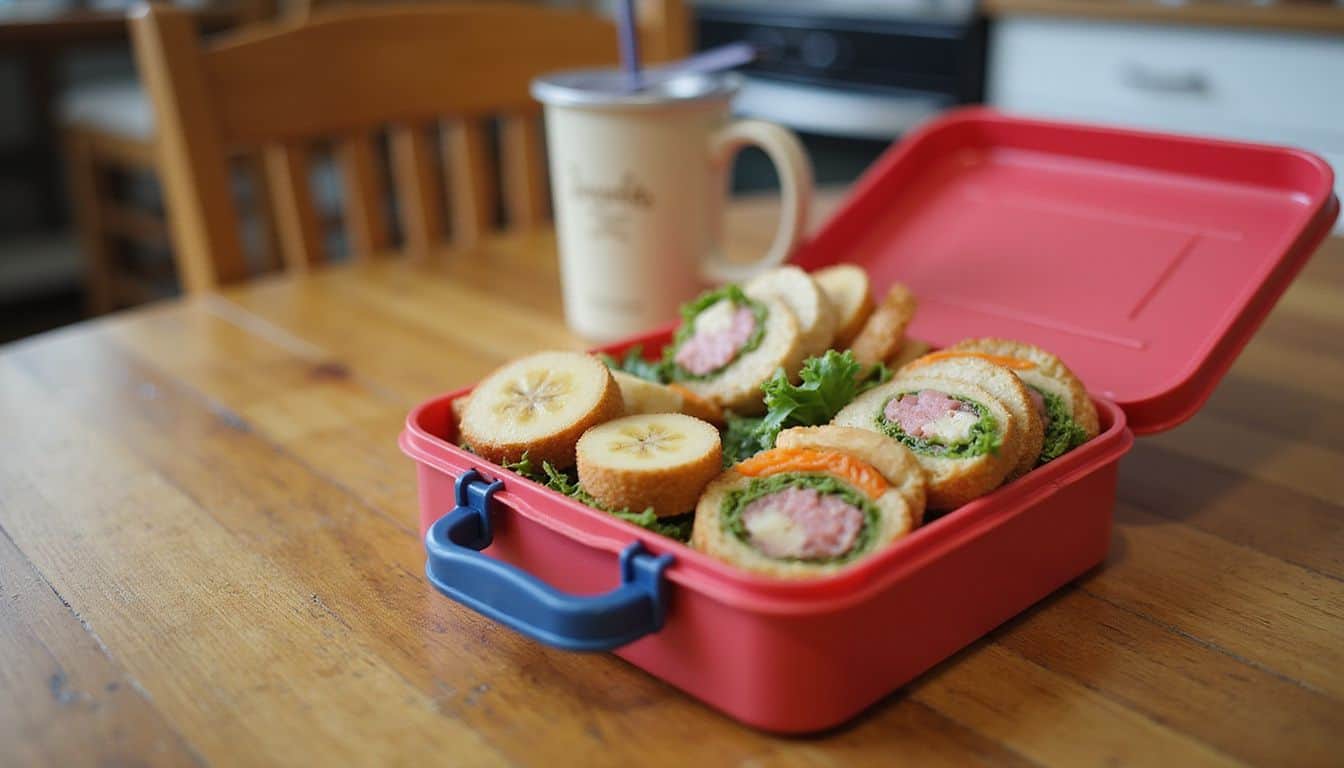Wondering what to pack in a lunch box that your kids will happily eat? A nutritious school lunch can boost energy, mood, and focus through the day. Here you’ll find 9 fun ideas like pinwheel sandwiches, banana sushi, and simple DIY Lunchables to keep lunchtime tasty and healthy.
Packing lunches is about to get easier!
Key Takeaways
Pack lunches filled with healthy proteins—such as turkey sandwiches, hard-boiled eggs, or peanut butter—and pair them with fresh veggies, fruits, and whole grains for lasting energy.
Kids usually need exposure to a new vegetable about 15 times before giving it a chance—so stay patient, keep offering, and they’ll eventually warm up to healthier foods.
Creative presentation helps make lunch more fun: try banana “sushi”, sandwich wraps sliced into pinwheels, or simple homemade “lunch kits” that let kids build their own meals.
Save yourself morning hassle by prepping some lunch items Sunday night; slice fruit, portion out snacks, or assemble sandwich ingredients so they’re ready for quick packing.
Staying hydrated boosts kids’ concentration at school, so give them water bottles flavored with fresh fruit slices or tasty homemade smoothies instead of sugary sodas and juice boxes.
Table of Contents
Essentials to Include in a Lunch Box
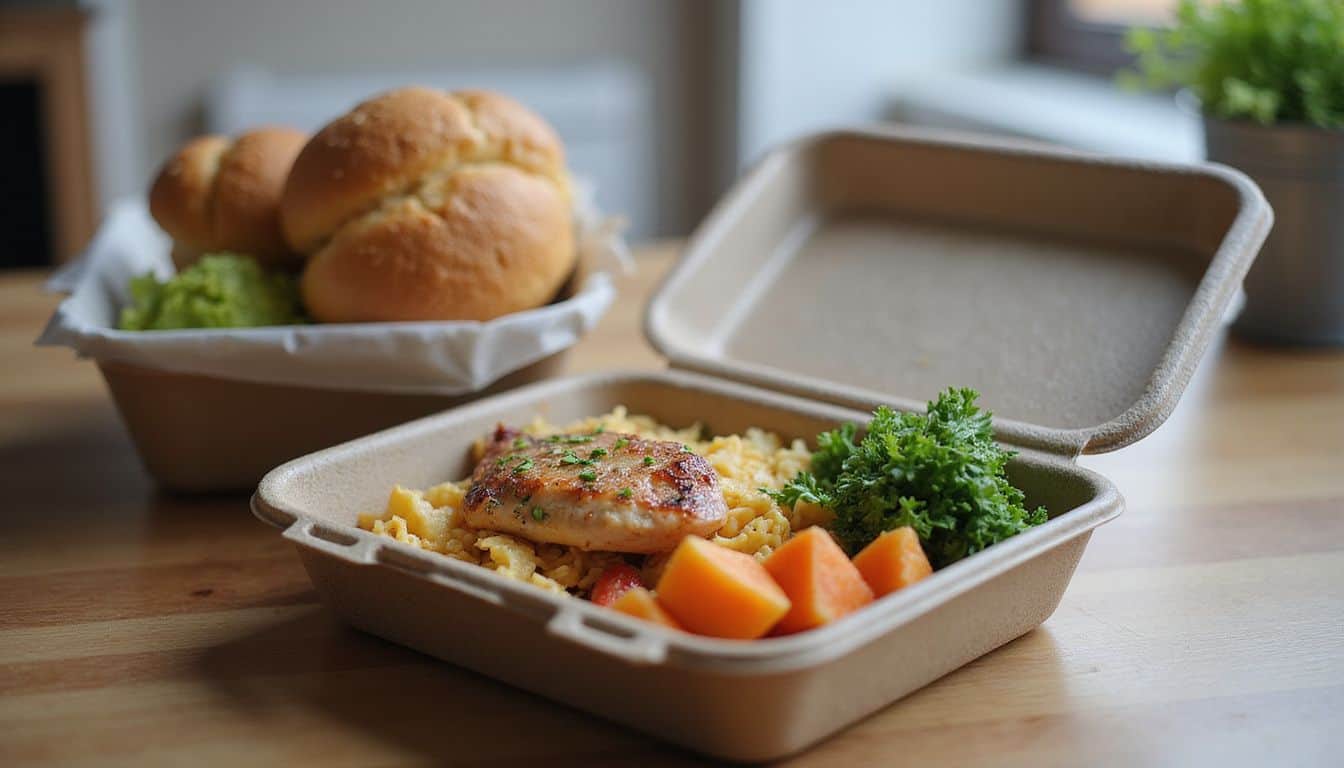
A good lunch box needs a mix of foods that give kids energy and keep them full. Pack a main dish with protein, add some fruits for natural sugar, and toss in veggies for crunch and vitamins.
Balanced main dish
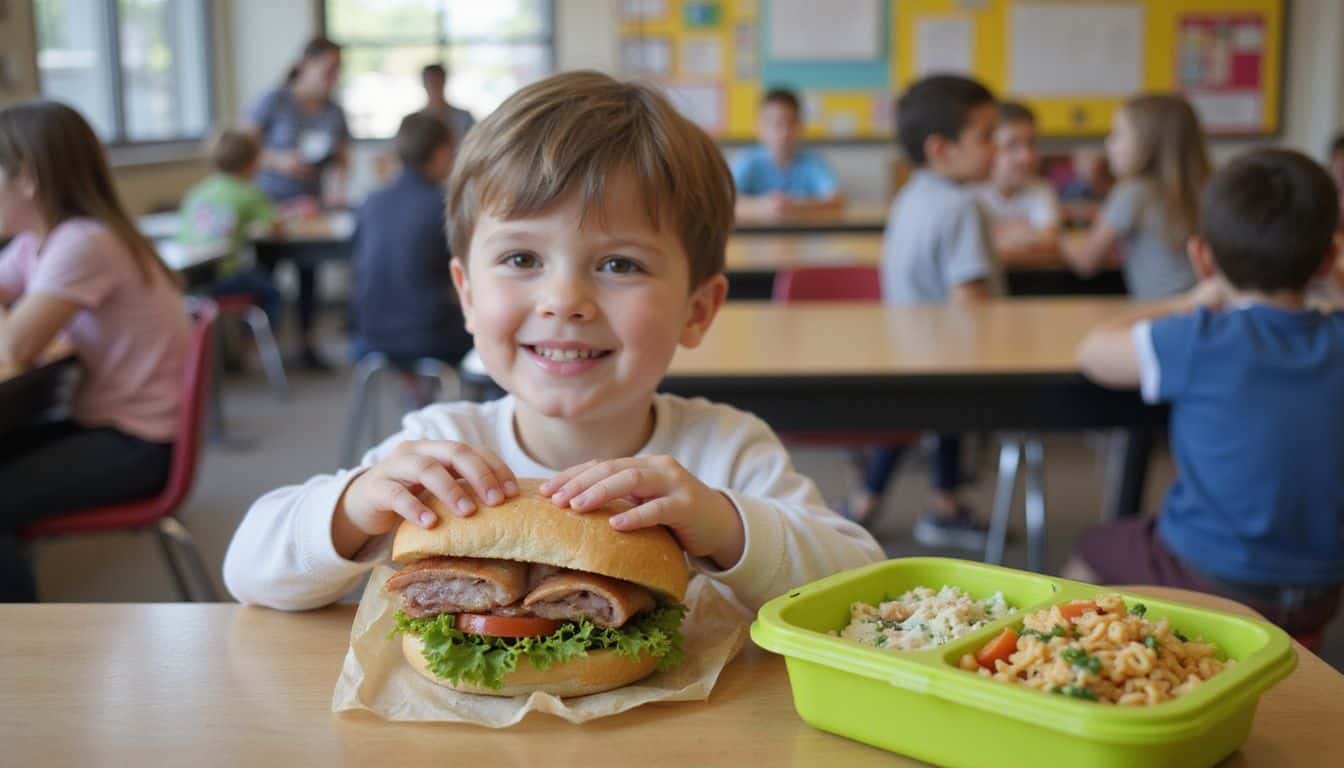
A nutritious main dish is the key to a successful lunch box. My kids enjoy deli sandwiches on whole grain bread, which give them energy for long school days. These sandwiches provide protein and complex carbs, all in a tasty bite.
Mini bagels also make great lunches—topped with cream cheese and thin cucumber slices for extra goodness. Pasta salads help win over picky eaters too! I toss whole wheat pasta with small pieces of veggies and a mild dressing, and it stays fresh until lunchtime.
The best lunch boxes include foods that fuel both body and mind throughout the school day.
For easy, stress-free mornings, I prep a few main dishes Sunday nights. Doing this saves me time and makes sure my kids get healthy meals all week. Nutrition experts suggest packing lunches with protein, dairy, fruits, vegetables, and starchy foods each day.
Last year, my daughter started refusing sandwiches, so I tried quesadillas filled with beans and cheese—now it’s her daily pick! Also, try to cut back on sugar by skipping pre-packed lunch kits loaded with salt and preservatives.
Fresh fruits
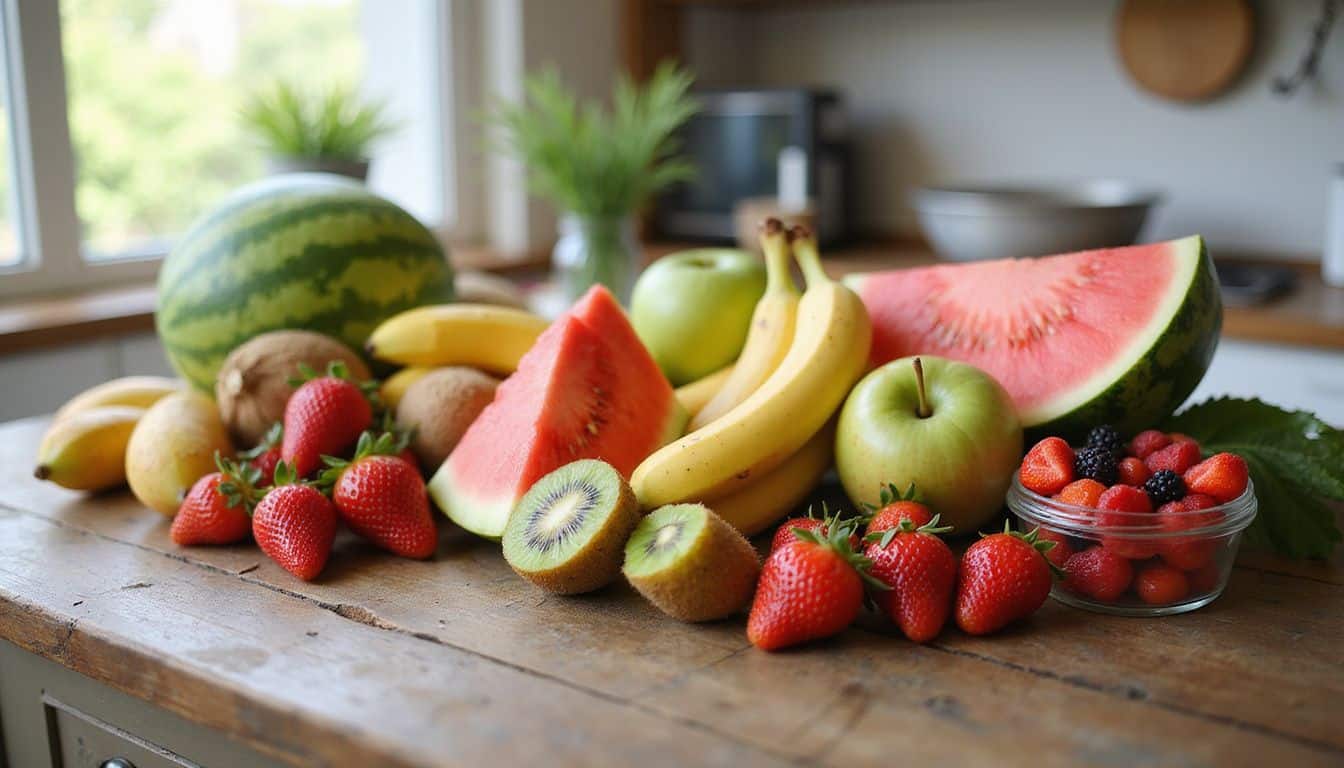
Fresh fruits brighten lunch boxes with vibrant colors and healthy nutrients. Children typically need about 2–3 servings of fruit each day, and active kids benefit from around 4 servings.
Strawberries give kids a healthy dose of vitamin C, and watermelon helps keep young ones hydrated on hot school days. Bananas offer potassium, plus they’re easy to pack with their handy, natural wrapper.
Apples such as Fuji vs Gala apples remain crunchy for hours, resisting browning even after slicing. Kiwi surprises children with its vivid green color and fun, tiny black seeds inside.
To add interest, cut fruits into fun shapes like stars or hearts—this small touch often convinces picky eaters to give fruit another shot! Berries deliver fiber and antioxidants in single, convenient servings—and they fit neatly into lunch containers.
Offering colorful fruit selections encourages kids to enjoy healthy foods and gives them key vitamins for growth and learning.
Fresh vegetables
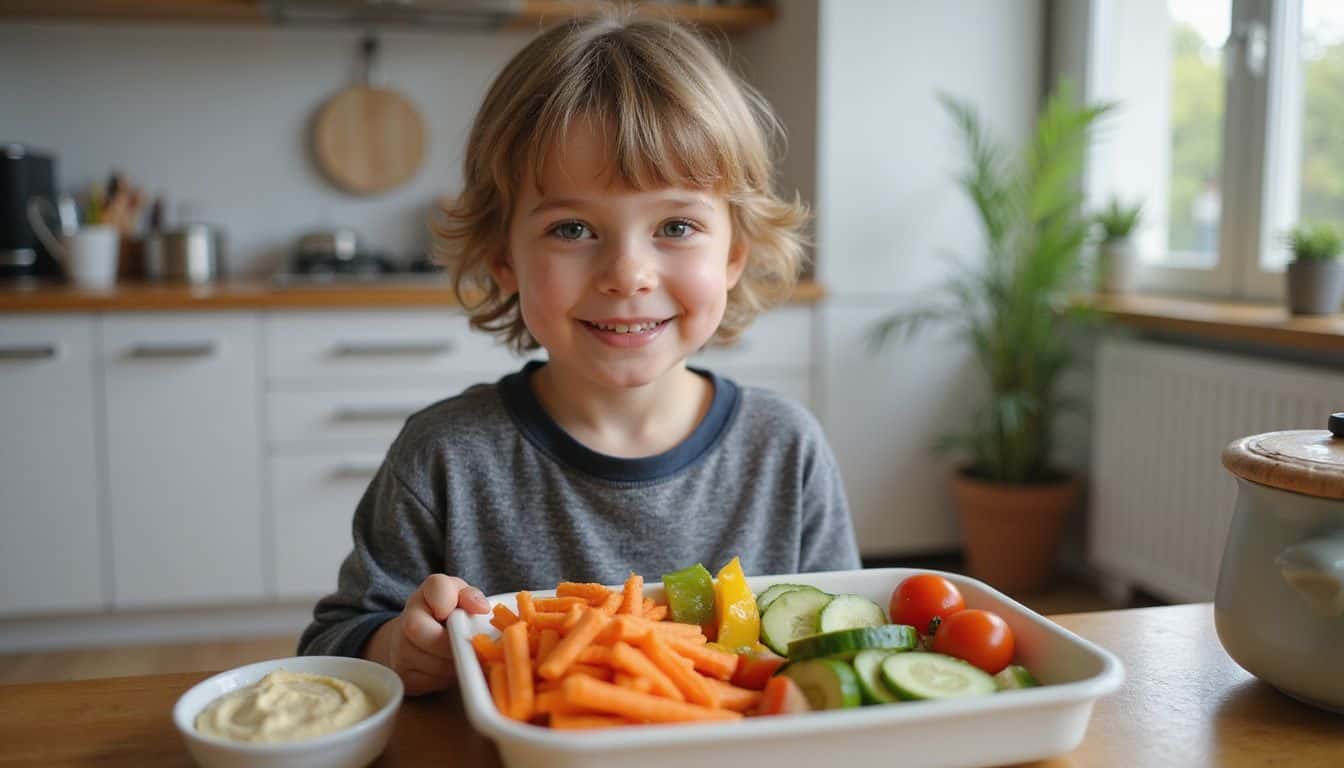
Bright veggies add satisfying crunch—and important nutrition—to your child’s lunch box. Try packing carrot sticks, celery slices, grape tomatoes, broccoli florets, or cucumber rounds, along with tasty hummus for dipping.
Bento-style lunch boxes keep everything neat, colorful, and fun. After including bell pepper strips several weeks in a row, my kids actually started requesting them!
Children sometimes need exposure to a new veggie about 15 times before they finally taste it, so don’t lose patience too soon. Experiment by shaping veggies into playful figures or pairing them with healthy fats, like tasty avocado dip, to enhance both nutrition and flavor.
Small actions like these deliver key vitamins and help kids build lifelong habits, keeping their hearts healthy in the long run.
Protein-Packed Options
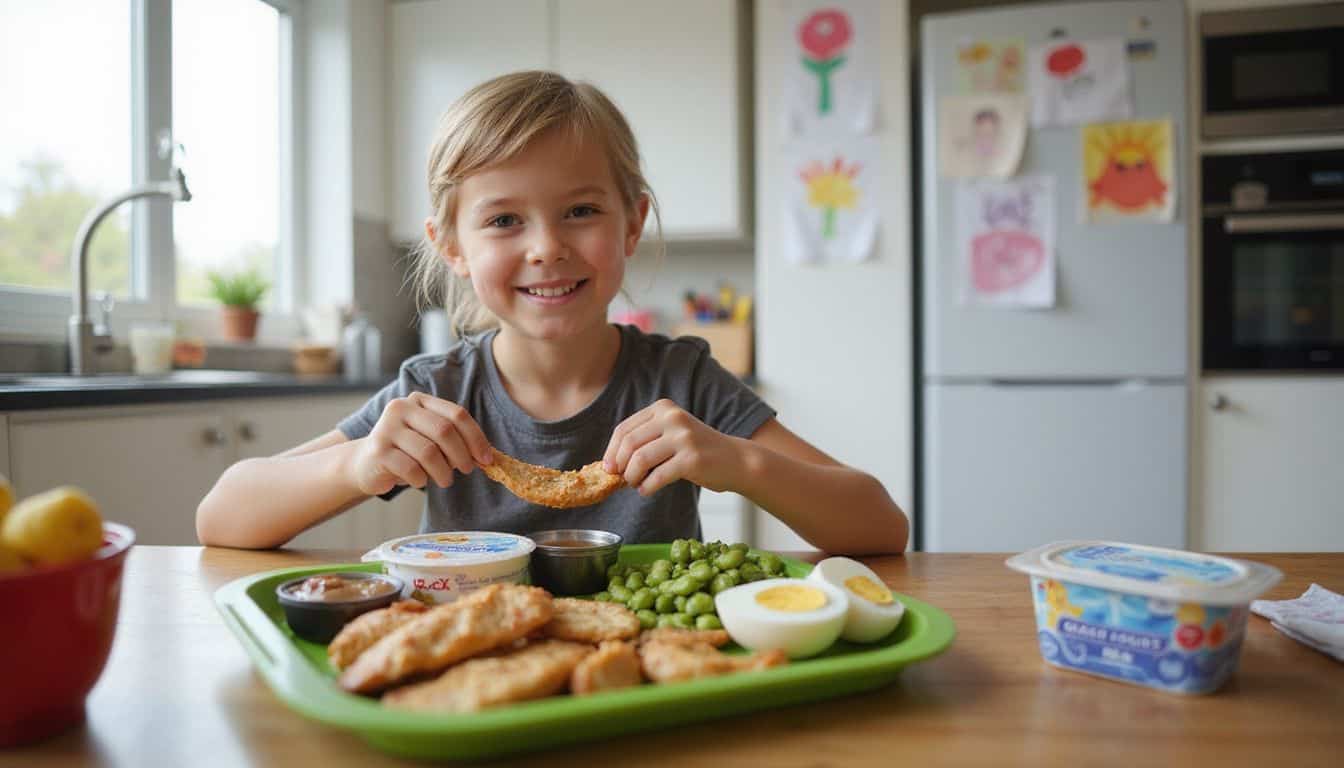
Kids need protein to grow strong and stay full until dinner time. Pack these power foods in their lunch box to boost energy levels during school hours.
Deli meat and cheese sandwiches
Deli meat and cheese sandwiches deliver the tasty protein boost children want at lunch. Mini sweet Hawaiian rolls make handy sandwich bases, small enough for little fingers to easily grip and enjoy.
Add layers of turkey slices (9 grams of protein), cheese (6 grams), and whole grain bread (4 grams) to keep young appetites satisfied all afternoon. Protein-packed sandwiches support growing muscles and help children stay energized through class.
A well-packed lunch isn’t just food—it’s fuel for learning and growing.
For added lunchtime fun, make pinwheel sandwiches by rolling deli meat and cheese into flatbread. Then simply slice it into small, colorful rounds that brighten any lunchbox. Pair sandwiches with fresh fruit for vitamins, or crunchy veggie sticks to provide fiber.
Busy moms can even prepare sandwiches the night before, store them in the fridge, and save valuable morning time, knowing their child’s lunch will actually get eaten.
Hard-boiled eggs
Lunch boxes don’t have to rely only on deli sandwiches—hard-boiled eggs are another tasty, affordable option. They’re loaded with protein and nutrition, yet cost just a few cents each.
My kids really enjoy them, because they’re filling, quick to eat, and easy to handle. On Sunday nights, I boil a big batch, so we have enough for lunches all week long.
Hard-boiled eggs taste great on their own, but they work well in other creative lunch ideas, too. Egg salad sandwiches on whole-grain bread boost fiber intake and keep everyone feeling satisfied.
Scotch eggs make a tasty surprise snack—just roll peeled eggs in sausage meat and bake until crispy.
For something different, slice hard-boiled eggs and stuff them inside pita bread with hummus and eggplant slices. This Mediterranean-style sandwich gives kids healthy fats and key vitamins needed for growing bodies.
Protein from eggs keeps hunger away until after school, perfect for busy afternoons. Eggs also offer special nutrients that support brain function during class time. My daughter enjoys hers with just a pinch of salt, while my son prefers his plain—paired alongside crunchy carrot sticks.
Nut butter and seed spreads
Nut and seed spreads add tasty protein power to your child’s lunch box. Almond butter mixed with cranberries is perfect for quinoa energy bites that kids can’t resist. If your child’s classroom has food restrictions—Sunbutter makes a great nut-free filling for homemade Uncrustables.
Sunbutter also contains plenty of omega-3 fats that boost brain health. Pair these creamy spreads with whole-grain bread or crisp apple slices for a blend of healthy fats and fiber kids need.
These tasty spreads help keep hunger under control until dinner, since they have monounsaturated fats that digest slowly. Kids love their creamy texture, and each bite provides important vitamins and nutrients.
Change things up—add a drizzle of honey or bits of dried fruits to create delicious flavors even picky eaters enjoy. These simple, wholesome spreads promote healthy eating habits without the excess sugar or added salt.
Healthy Carbohydrate Choices
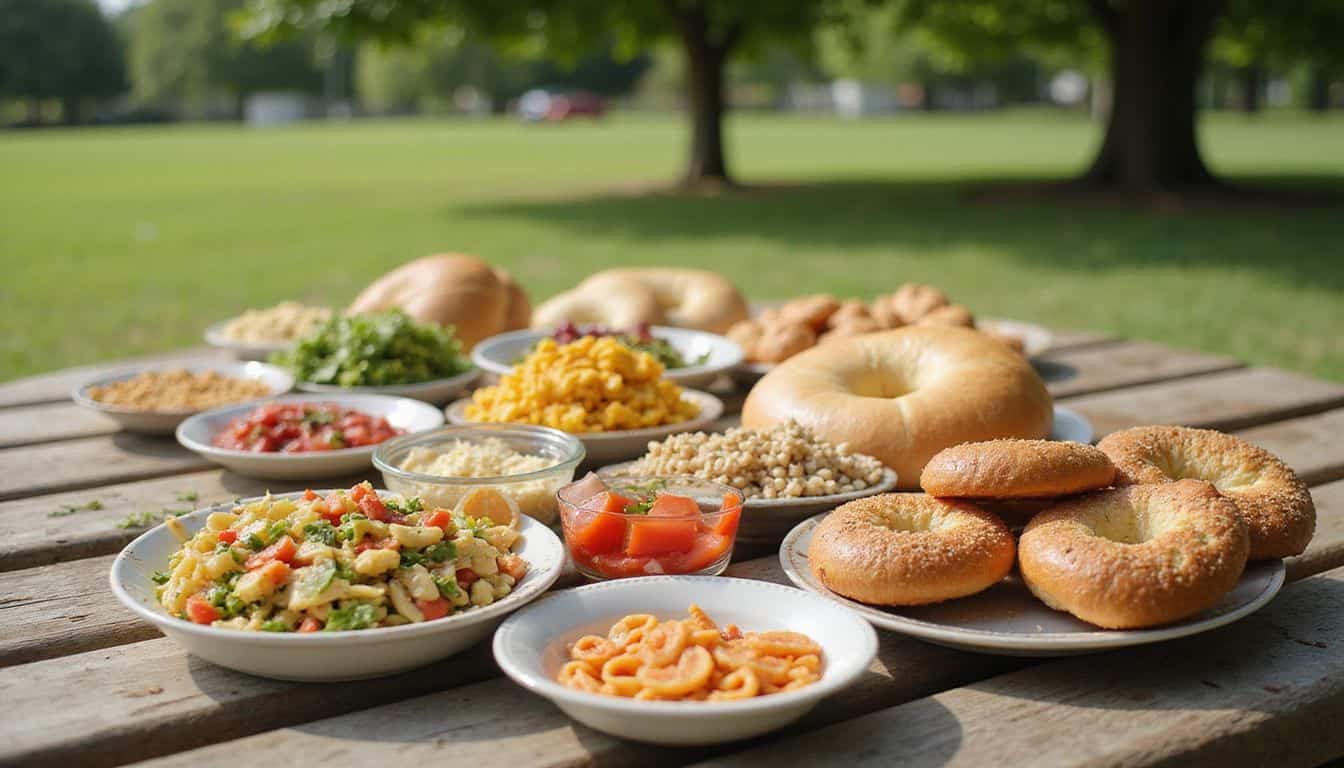
Whole grains, pasta salads, and mini bagels give kids the energy they need to learn and play all day long – check out our full guide for more tasty lunch box ideas that will make your child excited about healthy eating!
Whole grain bread
Whole grain bread is the ideal starting point for lunch box sandwiches your kids will actually enjoy. Packed with both soluble and insoluble fiber, this tasty option supports smoother digestion and keeps little bellies satisfied right up to the last school bell.
Parents can easily boost children’s nutrition by swapping plain white bread for whole grain options—providing extra vitamins and nutrients to keep kids energized and focused. To win over picky eaters, try cutting sandwiches into fun shapes with cookie cutters, or roll colorful fillings into playful pinwheel sandwiches.
Combining whole grain bread with protein-rich fillings helps deliver a balanced meal that fuels healthy growth and supports learning. Spread on natural nut butter for an easy protein hit, or layer lean lunch meats paired with avocado slices to add beneficial fats and creamy texture.
The Canada Food Guide even recommends whole grains as a daily eating choice since they help cut down the risk of heart disease and diabetes. Today, several brands offer softer, milder-tasting whole grain varieties perfect for picky little eaters, delivering all those great nutrients without complaints.
Pasta salads
Pasta salads give kids a fun, tasty lunchbox option. Cold pasta salad stays fresh all morning—no heating needed. Sesame Chicken Pasta Salad combines lean protein and bite-sized veggies for balanced nutrition.
Greek Pasta Salad, packed with feta, olives, and cherry tomatoes, delivers bold flavors kids love. And classic mac and cheese pasta salad always brings smiles from comfort-food fans.
A colorful pasta salad isn’t just food—it’s a little box of joy that makes lunchtime something to look forward to!
These salads travel easily in containers, especially those keeping wet and dry ingredients separate. Pasta’s starch offers steady energy, helping kids focus during afternoon classes.
Heirloom Tomato Salad adds vibrant color, plus vitamins kids need daily. Pasta salads even tempt picky eaters, letting parents cleverly slip in hidden veggies. Check out whole-grain pasta salads too—they offer fiber and extra nutrition perfect for growing bodies.
Mini bagels
Mini bagels can easily jazz up lunchtime for your kids. These small bread rounds deliver tasty bites with fewer calories than regular-sized bagels. My daughter loves them topped with cream cheese—she always finishes every crumb.
For extra protein, salmon slices make a tasty topping too. Mini bagels pair perfectly with healthy sides like yogurt, granola, fresh berries, and crunchy cucumber slices. Whole grains in these bagels provide carbs kids need, giving energy for busy afternoon lessons.
My children have fun creating their own “sandwich stacks”, with different fillings, after I slice the bagels in half. It’s a playful lunch idea that makes eating healthy simple and enjoyable.
Snacks to Add Variety
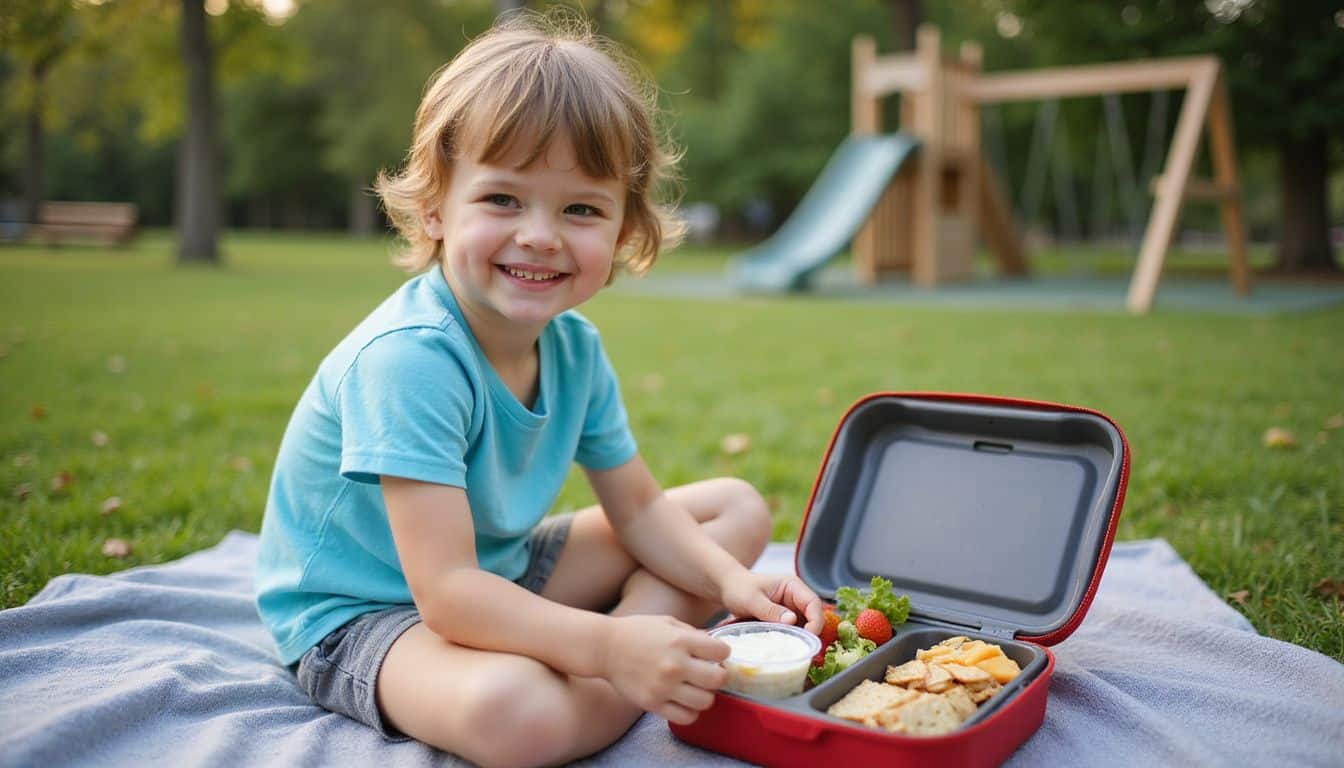
Kids need fun snacks that break the lunch box boredom. Mix up their midday meals with tasty options that add both nutrition and excitement to their day.
Hummus with crackers or veggies
Hummus makes an excellent lunchbox snack that most children genuinely enjoy. Packed with protein, this tasty dip goes perfectly with whole-grain crackers or crunchy veggies like carrots, cucumbers, bell peppers, and cherry tomatoes.
I fill small hummus containers for my daughter three times each week—and she always brings home an empty lunchbox. To keep things interesting, try rotating flavors like roasted red pepper, garlic, or avocado versions; these tasty options add variety without extra sugar.
Nowadays, many grocery stores carry handy single-serving cups of hummus, ideal for school lunches. These individual cups save time and keep the hummus fresh until mealtime. For added fiber and nutrients, mix colorful veggies—like red, yellow, and green peppers—for dipping.
The mix of soluble and insoluble fiber from vegetables aids digestion and provides essential vitamins. These vitamins also help children grow, learn, and stay alert throughout the school day.
Yogurt, granola, and berries
Greek yogurt is a tasty, protein-rich addition to any kid’s lunch box. Its creamy texture stays neatly inside containers, providing solid protein that keeps hunger at bay during afternoon classes.
For extra crunch, toss in some granola—it delivers both soluble and insoluble fiber, aiding smooth digestion. Fresh berries add vibrant color and natural sweetness, making the snack more appealing for little eyes and appetites.
Blueberries, strawberries, and raspberries offer helpful nutrients to fuel children’s growing bodies.
Make sure you store this yummy snack the right way, so it stays fresh until lunchtime. Keep berries separate from the yogurt to avoid sogginess—that way, the granola stays crisp too.
Many parents find this snack ideal for picky eaters who might otherwise turn down healthier foods. To make mornings easier, prepare several yogurt parfaits in advance. Natural sugars in berries offer steady energy—unlike sugary sports drinks and processed snacks, there’s no sudden energy dip later.
Trail mix or nuts
Trail mix is an ideal snack to pack into your kid’s lunch box—they’ll actually eat it. For a safe, school-friendly treat, try a nut-free blend of pumpkin seeds, sunflower seeds, and dried blueberries.
This blend gives your child plenty of healthy fiber (both soluble and insoluble), offering steady, lasting energy to help them through their busy day. Since many schools have strict “no nut” policies due to allergies, these tasty seeds deliver the same satisfying crunch and nutrients, minus the risk.
At home without allergy worries, you can toss in a handful of nuts for extra protein and good fats. Pairing trail mix with avocado slices creates a complete, tasty snack—even for picky eaters.
Plus, the USDA MyPlate guidelines recommend these nutritious options as part of a balanced diet. Up next, we’ll check out how hydration and drink choices match these snack ideas.
Creative and Fun Ideas
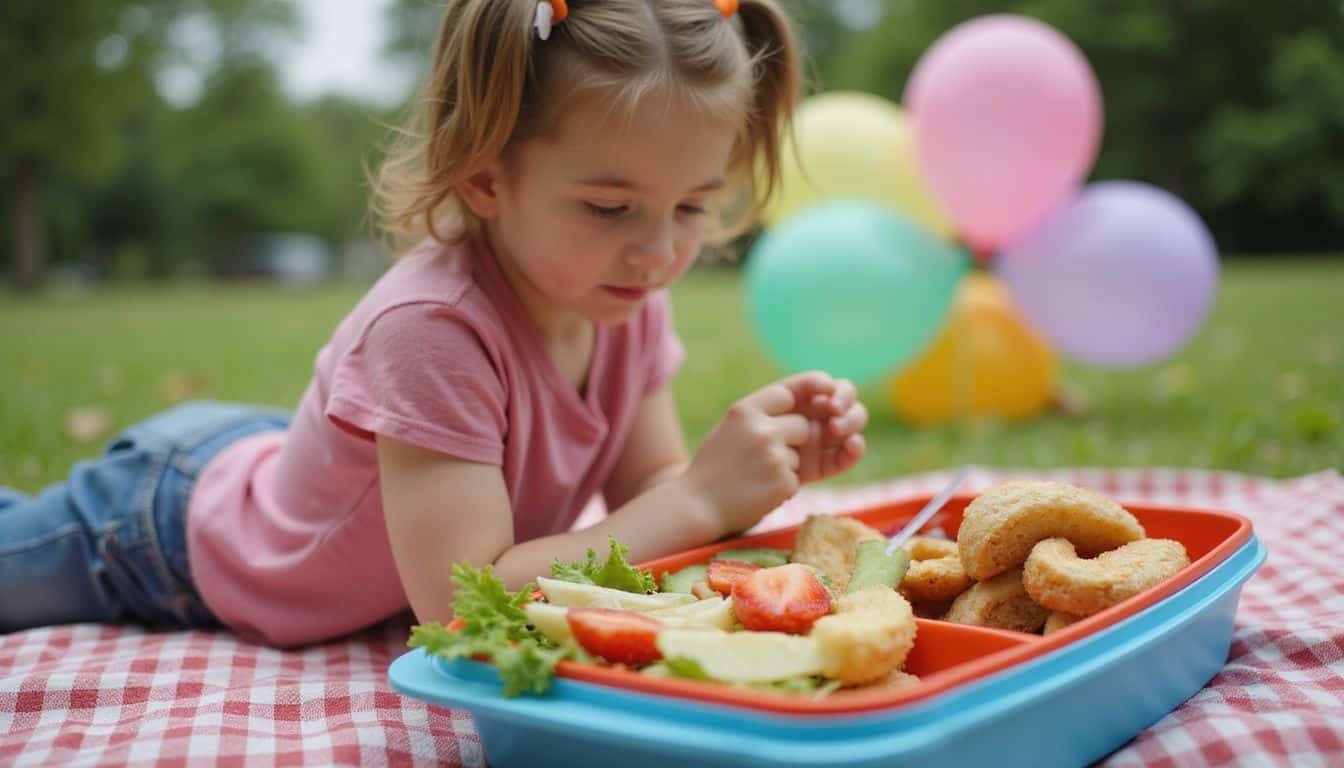
Kids love lunch boxes with a twist of fun. Try these ideas to make their meals more exciting and watch them finish every bite.
Pinwheel sandwiches
Pinwheel sandwiches brighten any lunch box—kids love their colorful spiral shape. These tasty rolls are easy to make using everyday ingredients like ham and cheese or turkey and cheese, neatly wrapped in soft bread.
For something sweeter, try cream cheese paired with fruit preserves before rolling. Once rolled up neatly, secure them with toothpicks, then slice into cheerful little spirals. These small bites are packed with lunchmeat protein and make tasty finger foods.
Moms appreciate pinwheels because their playful design helps overcome picky eating issues. The rolled sandwich style also helps prevent messy eating, great for school lunches. For an extra nutritional boost, add thin avocado slices for healthy fats, or tuck in some spinach leaves to sneak in more nutrients.
Spend some time prepping several rolls on Sunday night, wrap each tightly, and keep them chilled in the fridge. In the morning, quickly slice off fresh servings to ease those hectic weekday routines.
Banana sushi
Banana sushi makes lunch fun—and anyone can whip it up fast. Within just five minutes, simply spread your favorite nut or seed butter onto a tortilla, wrap it around a peeled banana, and then slice into bite-sized rounds.
Kids find it delightful since this clever snack looks like actual sushi. For added variety, sprinkle some dried apricots, granola, or even drizzle a little honey before rolling it up.
This easy combo delivers both carbohydrates from bananas and protein from nut butter.
These bright, tasty rolls offer fiber and important micronutrients that little bodies require. Bananas supply potassium, and seed butter gives kids healthy polyunsaturated fats. If schools don’t allow nuts, sunflower seed butter does the trick perfectly.
Pair these rolls with colorful berries or veggie skewers, and you’ve got a full lunch free from extra sugar. Instead of spending hours cooking, busy parents can quickly assemble this lunchbox-friendly meal, meeting dietary guidelines and keeping nutrition worry-free.
DIY lunchables
Kids enjoy building their own meals—and DIY lunchables make lunchtime extra special without the high store price. You can quickly put these kits together at home using basic items like whole-grain crackers, cheese cubes, and turkey or ham slices.
Toss in fresh berries or apple wedges for some natural sweetness and added fiber, too. Many moms say their kids eat more lunch because they have fun putting it together themselves.
Homemade lunchables are great because you can easily match foods to your child’s tastes. Try mini bagels with cream cheese and cucumber slices, or crunchy nachos topped with beans and mild salsa.
These homemade alternatives offer better nutrition and less sugar than store-bought lunch packs. The USDA suggests kids’ school lunches include protein, fruits, and whole grains—and DIY lunchables help you meet those guidelines in a fun and tasty way.
Hydration and Beverages
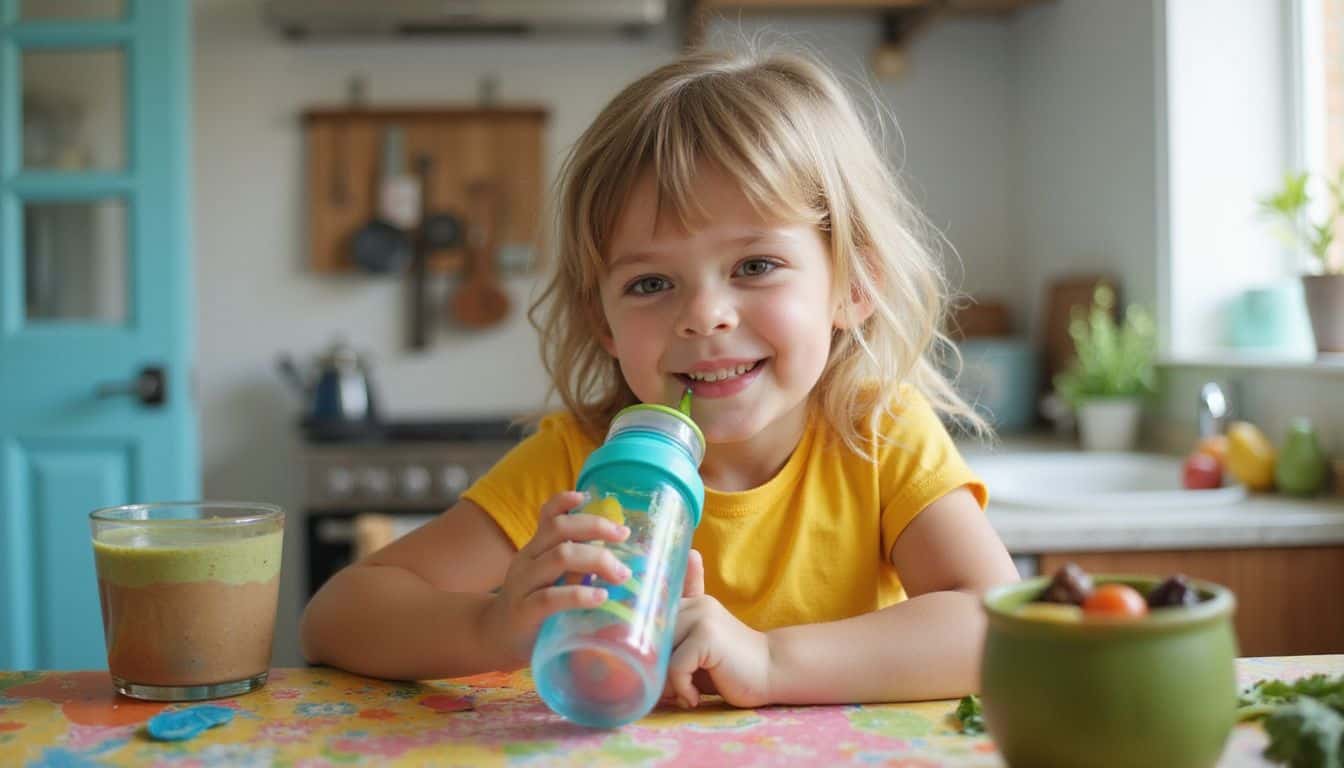
Kids need plenty of fluids to stay alert at school, so pack a colorful water bottle or a small homemade smoothie with hidden veggies for a fun twist – check out our next section for sweet treats that balance nutrition with fun!
Water bottles
Water bottles belong in every child’s lunch box—for good reason. Many kids don’t get enough water at school, and this lack of hydration can make them tired and less focused in class.
But there’s an easy fix: choose bottles with bright colors, cool patterns, or popular cartoon characters. These fun designs encourage children to drink more throughout the day.
Insulated water bottles keep drinks cold, ideal for hot weather or active gym sessions. For small hands, choose compact bottles with tops that flip open easily. Older children might prefer bottles showing ounce-marks along the side to help them track how much water they’re drinking each day.
Since some schools restrict certain bottle types, double-check the guidelines before you buy one. To make plain water more interesting, mix in slices of strawberries, citrus wedges, or blueberries.
Fresh fruit adds great taste, without the unwanted sugars or caffeine found in juices and sodas.
Homemade smoothies
Homemade smoothies are an ideal drink choice to pack in your child’s lunch box. My kids absolutely love these chilled fruity blends—delicious, easy to make, and filled with nutrients.
One of their favorites is my Mango Peach Smoothie, offering 344 calories, 15 grams of protein, and 441 milligrams of calcium per serving.
These smoothies make perfect quick breakfasts, tasty lunchbox treats, or refreshing snacks after school. All it takes are simple ingredients like yogurt, fresh berries, and a little bit of juice.
To boost protein content, add some extra nutrition using hemp protein vs whey protein—perfect for helping your children grow stronger and healthier.
Smoothies are also great for ensuring kids eat their daily fruit servings, without all those extra sugars found in packaged drinks.
A useful tip is freezing smoothies overnight in small containers. They thaw perfectly by lunchtime, and double as ice packs—keeping the rest of the lunchbox fresh and cool. Usually, I whip up large batches on Sunday evening, so they’re ready to grab and go throughout the week.
Let your kids join in picking ingredients, loading fruits in the blender, and watching their choices become bright, colorful beverages. Toss in avocado or oatmeal to add healthy fats and fiber that fight hunger all afternoon long.
Now, let’s explore some delightful sweet options to include in your child’s lunchbox.
Treats and Desserts
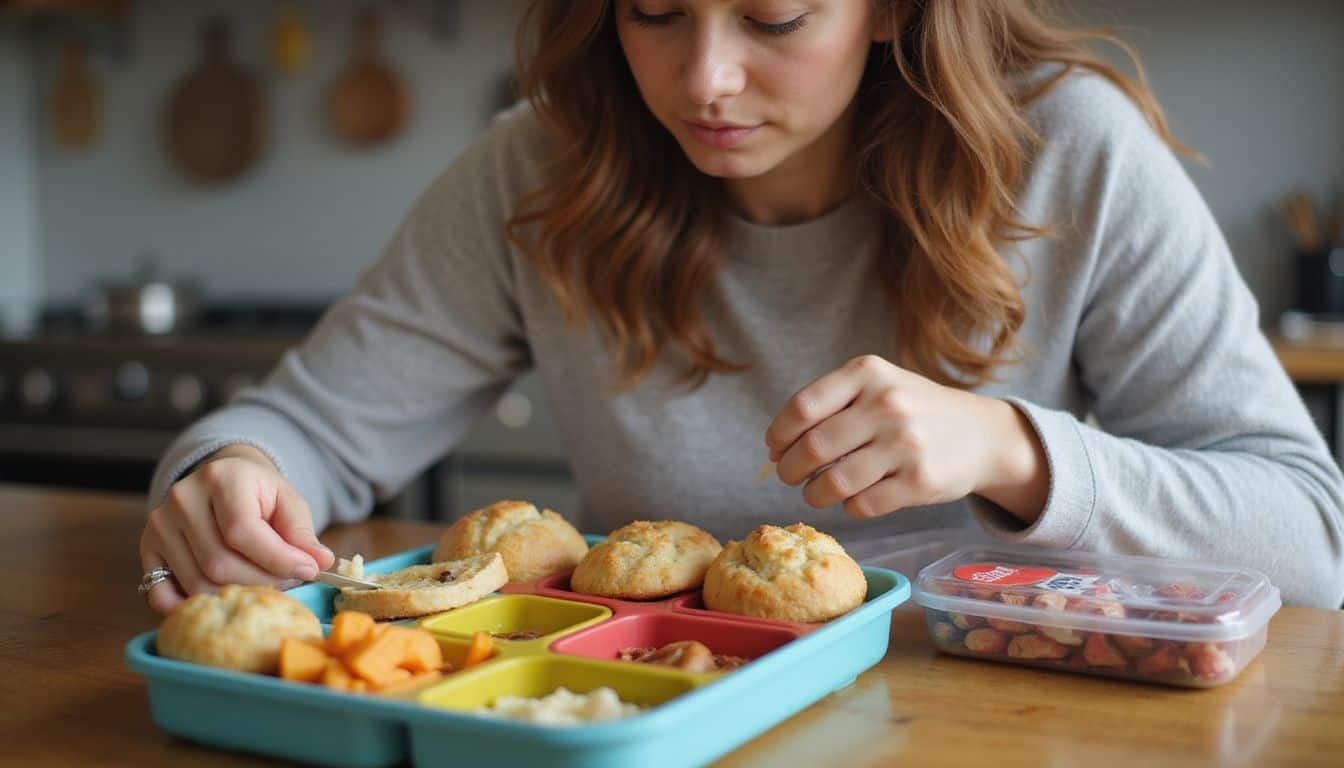
Treats and desserts add a sweet touch to your child’s lunch box – try homemade muffins with less added sugar or pack small portions of store-bought snacks that still feel special without the sugar crash later…
Keep reading for more tasty ideas that balance fun with nutrition!
Homemade muffins
Homemade muffins are a tasty, nutritious choice perfect for your kid’s lunch box. My top recipes are Chocolate Chip Wheat Mini Muffins and Banana Walnut Muffins. Each Sunday afternoon, I whip up a batch, then freeze the extras in zip-top bags.
On school mornings, the kids grab frozen muffins, and they’re ready to eat by lunchtime. These mini muffins contain whole grain fiber and have less sugar than store-bought snacks.
For busy moms, muffins offer an easy way to add nutrition into kids’ diets. My daughter enjoys mixing berries into the batter—creating yummy treats better than sugary granola bars.
The beauty is, you pick the ingredients yourself. Swap regular flour for whole wheat, reduce sugar, or even add mashed avocados to boost healthy fats. Small changes like these increase nutritional value, without losing the flavor kids love.
Healthier store-bought snacks
Today’s grocery aisles have plenty of nutritious snack options perfect for your child’s lunch box. For instance, That’s It. Mini Bars pack whole fruit into tasty snacks kids actually enjoy—without added sugar or artificial stuff.
The bars have both soluble and insoluble fiber, helping your little ones stay full straight through until dinner. Go Macro Bars offer another healthy choice, made from organic ingredients and promoting farming methods that care for the planet.
Busy parents can confidently toss these in lunch bags, even on chaotic mornings.
Savvy moms and dads know the best snacks usually have fewer ingredients and less sugar. Trail mixes without candy provide protein and good fats to keep energy high. Whole grain crackers and individually wrapped cheese slices make tasty mini-meals that kids love to eat.
Single-serving hummus cups pair nicely with veggie sticks or crunchy plantain chips for an appealing texture and satisfying flavor. These grab-and-go options reduce stress on busy mornings, while still giving your child the nutrition they need to stay alert during afternoon lessons.
Tips for Packing a Lunch Box
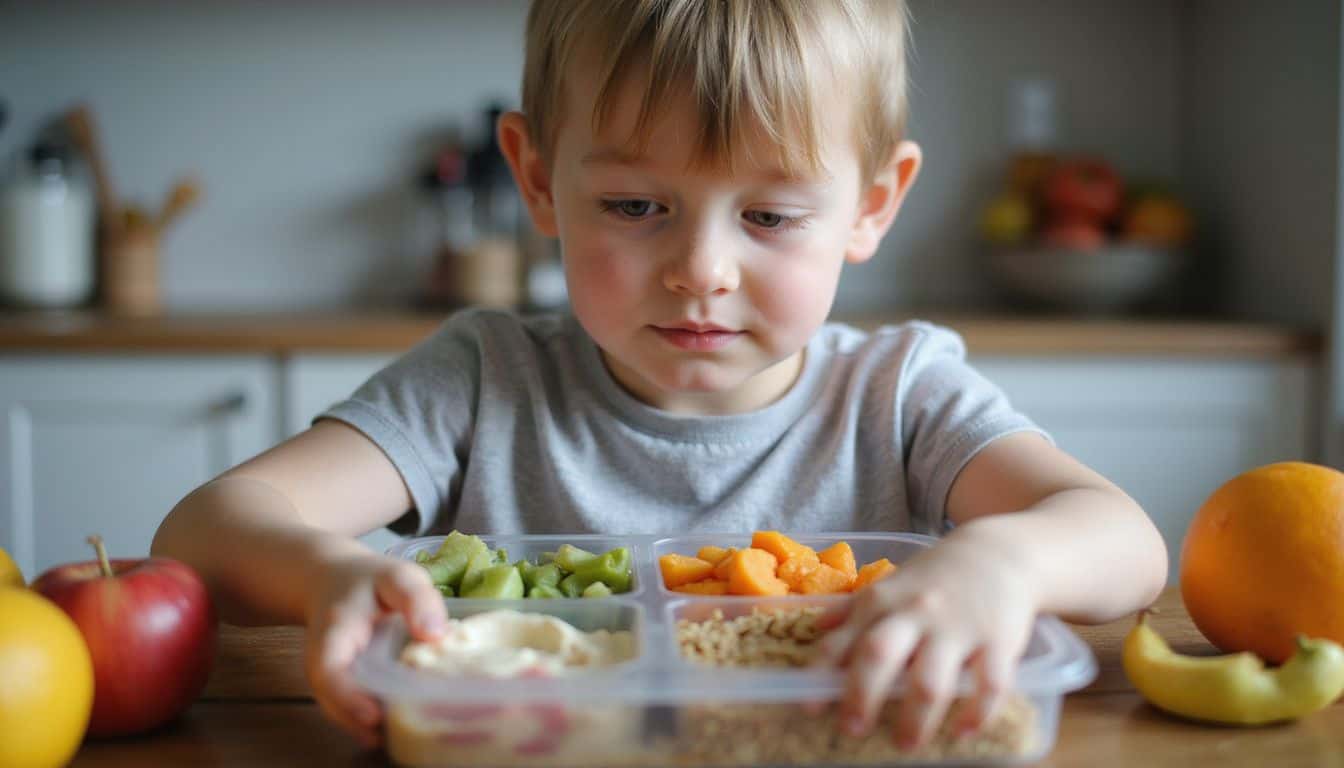
Packing a smart lunch box means using the right tools like insulated containers to keep hot foods warm and cold foods fresh, plus adding small ice packs for perishables like yogurt or cheese – read on to learn how simple prep tricks can save you time while making sure your kids eat a balanced meal with whole grains and fresh fruits!
Use insulated containers
Insulated lunch containers help you keep hot foods warm and cold foods chilled for hours. Before adding hot dishes like pierogies or grilled cheese sandwiches, pour boiling water into the container.
Let it sit for about a minute, then empty the water and add your food. Doing this simple trick helps food stay warm until lunch. For cold selections like overnight oats or pasta salads, include two cold packs or ice blocks to keep them safely cool until mealtime.
Using insulated containers brings clear health advantages, since they hold foods at safe temperatures and stop harmful bacteria from growing. Lots of brands now offer kid-size options—complete with fun colors and playful characters—that children enjoy opening at lunch.
The next time you’re shopping, pick containers that seal tightly and won’t leak food all over backpacks. Now, let’s check out how to keep wet items separate from dry snacks in your lunchboxes.
Separate wet and dry foods
Keep wet and dry foods separate—kids enjoy their lunches more this way. No one likes soggy sandwiches! Bento boxes with distinct sections work perfectly for this job. Place juicy berries in one compartment, crackers or bread in another.
Use small containers to keep dips like hummus separate from veggies until snack time. Silicone cupcake liners can also make handy dividers inside a regular lunch box. This trick prevents moisture from making crunchy foods mushy.
Your child gets to enjoy fresh snacks, not damp, sad sandwiches. Smart food storage transforms packed lunches into meals kids love to eat. Here are some simple tips to pack lunch boxes with ease.
Pack ahead for convenience
Smart moms save time by preparing school lunches ahead—right after separating wet and dry foods. Making lunch the evening before school cuts morning stress dramatically. Some moms even prep lunch boxes for three or four days at once, then pop them in the fridge.
Airtight containers guarantee fresher meals, preventing sandwiches from turning soggy and veggies from wilting. Advance meal prep is especially helpful for busy women balancing work and family life.
For many parents, Sunday meal prep creates a smoother, calmer week. Just an hour spent washing and slicing fruits, portioning trail mix into snack bags, or tossing together pasta salads makes mornings easier.
Storing them in clear containers speeds up packing lunches each day. Organizing meals this way also reduces food waste—cutting down what gets thrown out—and lets you manage groceries better.
Your kids get tasty, nutritious meals, and you gain precious extra moments of quiet each morning.
How Will Lunch Box Ideas Evolve in 2025?
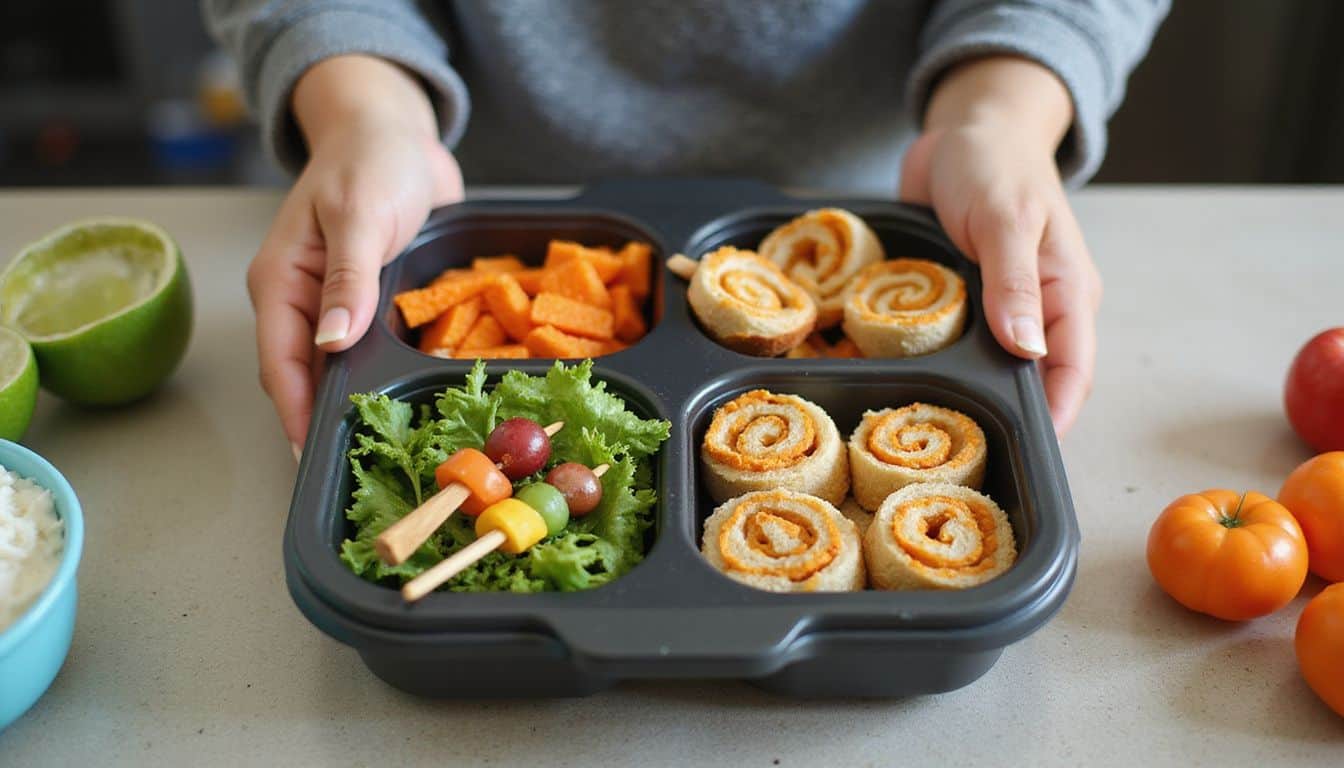
In 2025, lunch boxes will emphasize plant-based foods with vibrant colors and fresh ingredients. Bento-style boxes, with separate compartments for each food group, will help moms pack balanced meals and cut down on waste.
Kids will love personalized lunches, like breakfast favorites—think mini pancakes or yogurt parfaits—making midday meals fun again. Most schools will advocate for eco-friendly choices, replacing plastic containers with bamboo or recycled alternatives.
Mobile apps will make it easy for parents to track their child’s meals, ensuring kids eat enough protein, starch, and fiber, even compared to drinking baby formula.
Food allergies will strongly influence lunch-packing routines, leading parents to choose nut-free items and clearly labeled foods for safety. Creative options, like colorful pinwheel sandwiches, playful kabobs, or pizza-shaped veggies, will add excitement to nutritious eating.
The USDA school meal guidelines will encourage balanced meals packed with fresh fruits and veggies. Moms will prefer smaller portions of assorted foods, rather than large sandwiches, letting children explore new tastes.
These small changes will curb food waste, teach kids about sustainability, and reinforce positive eating habits early.
People Also Ask
What are some healthy lunch box ideas for kids?
Include fruits like berries—they offer fiber that’s good for digestion. Whole grain breads or pasta also provide energy and nutrients needed for growth. The USDA advises balancing carbohydrates, proteins, and healthy fats in kids’ lunches. Try organic apples or bananas as tasty alternatives to packaged snacks. Keep sugary beverages out, and opt instead for water or milk.
How can I make school meals more fun for picky eaters?
Try offering perogies crafted into playful shapes to attract kids’ attention. Transform breakfast favorites—pancakes or waffles—into lunchtime treats. Familiar foods like peanut butter sandwiches or homemade pizza slices often encourage picky eaters. Variety helps, but always keep it simple and relaxed.
What does the U.S. Department of Agriculture suggest for children’s lunches?
The USDA emphasizes balanced diets rich in nutrients for children. Their guidelines aim to prevent hunger and help kids grow strong and healthy. Programs like the Women, Infants, and Children (WIC) initiative give nutritious food guidance and agricultural education. USDA school meal programs also help maintain a stable food supply.
How can I prepare lunch box items if I’m short on time?
Make easy meals ahead of time, ideally on weekends or evenings before school days. SNAP (Supplemental Nutrition Assistance Program) provides helpful tips and resources for quick meals. Sharp kitchen tools, like quality knives and sharpeners, speed up fruit and veggie prep—saving you plenty of precious morning minutes.
What sustainable options can I include in my child’s lunch?
Choose products from organic or sustainable farms whenever possible. Used coffee tins or jars can easily become reusable lunch containers—saving money and reducing waste. Veggies grown through urban agriculture practices offer healthy choices while teaching your child about conservation and environmental care.
How can I ensure my child’s lunch stays fresh until lunchtime?
Select lunch items that stay fresh naturally, such as carrots, apples, or dried fruit, since these resist wilting or spoiling quickly. For meats or dairy products, always use insulated lunch containers to maintain safe temperatures. Food safety organizations like FSIS set clear guidelines for packing perishable foods properly—containers meeting these standards can easily be found online or in stores.
References
https://www.bbcgoodfood.com/howto/guide/school-packed-lunch-inspiration/
https://weelicious.com/12-essential-lunch-box-fruits/
https://holleygrainger.com/how-to-add-more-vegetables-to-your-childs-lunchbox/
https://www.theleangreenbean.com/high-protein-kids-lunch-ideas/ (2023-10-10)
https://www.thekitchn.com/10-ways-to-turn-hard-boiled-eggs-to-lunch-247218
https://forlunch.pro/kids-lunchtime-protein-packed-delights/
https://nutritionsource.hsph.harvard.edu/kids-healthy-lunchbox-guide/
https://www.allrecipes.com/gallery/kid-friendly-lunch-box-pasta-salads/ (2021-03-24)
https://www.eatingbirdfood.com/kids-lunch-box-ideas/
https://onmykidsplate.com/what-to-eat-with-hummus/
https://www.momables.com/diy-lunchbox-parfait/
https://www.theleangreenbean.com/nut-free-trail-mix/ (2023-04-21)
https://www.busylittlechefs.com/easy-pinwheel-sandwiches/
https://themanylittlejoys.com/banana-sushi-fun-healthy-snack-kids/
https://theeverymom.com/school-lunch-ideas-for-kids/
https://www.laurafuentes.com/healthy-smoothies-for-kids/ (2025-02-26)
https://moneywisemoms.com/homemade-muffin-recipes-2/
https://www.usda.gov/about-usda/news/blog/pack-it-safe-pack-it-smart-back-school-lunchbox-packing-essentials (2024-07-25)
https://www.whatlisacooks.com/school-lunch/make-ahead-school-lunches
